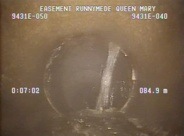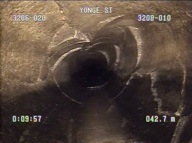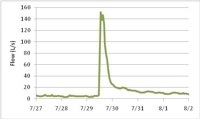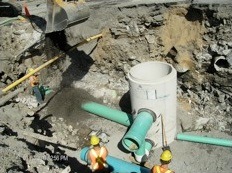What the City is doing about flooding
Introduction
Excess water getting into the sewer system is a problem because it reduces the capacity of the pipes to carry sewage to the wastewater treatment plants. This excess water is otherwise clean storm runoff or groundwater, referred to more technically as “extraneous flows” or “inflow and infiltration”. For more detail, visit our Extraneous Flows page.
This excess water is a big contributor to basement flooding since it can quickly fill up the sewer system during a big rain or snow melt. When the sewer is full, sewage has no place to go and this can cause both basement flooding and overflows to the environment.
The excess water can come from all sorts of places on the sanitary sewer system. They come from both private property, as well as municipally-owned property. Much of the information on this website is intended to help private-property owners reduce extraneous flows that come from their property. But, what is the City doing? Read on.
What are the typical issues within the municipal infrastructure that might contribute to excess water?
The problems within the municipal infrastructure are different than on the private-side. Here are some of the more common types of problems.
Leaky joints
Sewers in the street tend to be pieced together with multiple segments of pre-made pipe. Newer materials (plastics) generally come in longer lengths with better joints than in the past. Many materials used over 20–30 years ago, such as clay, concrete and “AC” pipe, came in much shorter sections and have a lot more joints.

Joints are usually the weak point in pipe systems where issues can develop. The biggest problem with joints is that over time, the gaskets degrade and leakage can then occur. These leaks are usually fairly slow, but constant. One or two leaks don’t amount to much of a problem, but lots of them do.
Cracks and defects
As sewer pipe ages, traffic and construction on the street above add stress, and may cause sewers to develop cracks and defects. Similar to joints mentioned above, these may allow groundwater to leak or run into the sewer system. Leaks can be minor or major.

Cross-connections
Sanitary sewers are meant to carry only sanitary sewage, not storm runoff. However, at times, whether by mistake or out of necessity during construction, a source of storm water may have been connected into the sanitary sewer. These are called cross-connections. They contribute potentially large amounts of storm runoff to the sanitary sewer.
All of the above issues are problematic at all times. However, they are especially problematic during wet weather (heavy rainfall or snowmelt), since there is usually a lot more water originating from these joints, cracks, defects and cross-connections. It is during heavy rainfall and snowmelt when sewage backups and overflows are most likely to take place.
What is Utilities Kingston doing about it?
Utilities Kingston has a number of programs and projects dedicated to addressing the problems of extraneous flows.
- Flow monitoring – The flows in sewers are monitored in specific locations to help us identify where the problems are located, and where they are the worst. This helps us prioritize the physical work that needs to be done. A typical data plot from a flow monitor is shown for the July 29th, 2011 rainfall event. Flows increased over 10 times their normal amount during the peak of the event.

- CSO monitoring – Overflows are an unfortunate reality based on the way sewers were built in the past. Generally, it is long term infrastructure renewal programs that are necessary to decrease overflows. Utilities Kingston monitors the overflows and posts this information on our Bypass Log webpage.
- Master planning – The Sewer Master Plan was completed in 2010, along with a Pollution Prevention and Control Planning update. These studies are important to help us identify where bottlenecks exist in the system, and to identify major infrastructure projects that are required to maintain or increase capacity to support future growth, and to progress with reduction of sewer overflows.
- Sewer inspection – Utilities Kingston administers an annual closed circuit television inspection program. This involves running a small mobile camera through the sewer and recording the condition and defects as it moves through it. Information obtained from these inspections is used to identify what remedies are required to fix pipes. We then prioritize these improvements into infrastructure rehabilitation or renewal projects. Utilities Kingston strives to inspect roughly 10% of the sewer system every year.
- Excess water reduction – Utilities Kingston administers annual contracts specifically for “extraneous flow” reduction. Focused on finding and sealing those leaky joints, cracks and defects, this program is evolving as we learn what works best. It also focuses, by use of fog testing, on identifying and eliminating cross-connections.
- Sewer separation – The City of Kingston is a historic City, and along with this historic nature, comes some historic infrastructure. In the past, combined sewers were built to collect both sanitary sewage and storm runoff together. Inherently, these systems are more subject to flooding. However, they were also protected from surcharge by built-in overflows.

The City of Kingston has an ambitious sewer separation program. This involves eliminating combined sewers and replacing them with a dedicated sanitary sewer and a dedicated storm sewer. Examples of this include the big reconstruction project on Princess Street in 2010, and future phases as the City progresses up Princess Street towards Divisions Street.
- Infrastructure renewal – The City of Kingston and Utilities Kingston work together on joint reconstruction projects. Every year, approximately 20–30 blocks of City streets are “reconstructed”, which includes not only repaving the road, but replacing the infrastructure beneath it. As part of this, new sewers are built and this gets rid of the leaky pipes and joints.
- Sewer lining – In some cases, sewers that are leaky, but still in otherwise decent shape, can be lined with a cured-in-place fibreglass liner. This liner essentially replaces the pipe and is naturally water-tight without joints.
The City of Kingston and Utilities Kingston have numerous programs concurrently working together to help reduce the amount of excess clean water getting into the sanitary sewer system. By doing this, and working with Kingston homeowners, together we can make a difference and have meaningful reductions in sewage backups!
